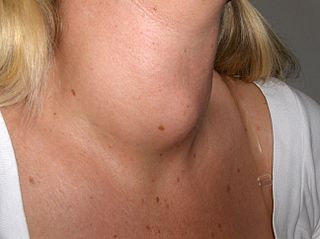Do I have a goitre?

When a thyroid gland is enlarged it causes a visible swelling on the front of the neck this is called a goitre. Most of these are painless although some may cause difficulty in swallowing, difficulty in breathing or hoarseness.
The vast majority of goitres in the world population is caused by lack of Iodine (which is mainly found in milk and seafood and a common cause of an underactive thryoid) Indeed you may have heard this condition called “Derbyshire Neck”- this came about because parts of Derbyshire are the furthest away from the ocean in the UK and so locals displayed the condition having eaten less seafood than much of the rest of the population.
If you would like to know more about the importance of maintaining good levels of iodine please click here
You might be interested to know that the World Health Organisation has a grading system for goitres:
|
The WHO Goitre Grading System |
|
|
Grade |
Features |
|
0 |
This is when the goitre is not palpable or visible even when the neck is extended. |
|
1 |
When the goitre is palpable |
|
1A |
Goitre detected on palpation |
|
1B |
Goitre palpable and visible when neck extended |
|
2 |
Goitre visible when neck is in the normal position |
|
3 |
Large goitre visible from distance |
In fact there are two types of goitre:
- Diffusely enlarged
- Nodular
Of course it is important to request a diagnosis to find out which you may have. Firstly in order to treat it and secondly to rule out the 5% risk of malignancy in patients with thyroid nodules.
Examination of the goitre often reveals why is has occurred. For example a diffusely enlarged goitre with an accompanying systolic noise (known as a bruit) may indicate Graves Disease. A painful goitre may suggest viral thyroiditis (a temporary condition sometimes prompted by flu or mumps) or a haemorrhage into a thyroid nodule.
Management of a Goitre
Physiological goitres will usually resolve spontaneously as they occur most often in females aged between 15 and 25 due to hormone production during puberty or pregnancy. They are not connected with an ongoing underactive thyroid condition.
Graves Disease has three main treatment options: antithyroid therapy, surgery or radioiodine – the latter of which has consistently been shown to the safest and most efficient therapy.
Hashimoto's Thyroiditis is an autoimmune condition that results in thyroid failure and thyroid swelling and treated with thyroxine.
Nodular Goitre – a fine needle biopsy is usually the first step to ascertain whether nodules are benign or malignant. Patients who have been told their goitre is benign usually have the biopsy repeated at three months and can then be discharged.
If the goitre is shown to be malignant and the nodules are more than 1 cm removal of the entire thyroid will be necessary and this is followed by treatment with radioiodine and thyroxine.
I think it’s important to repeat that a diagnosis of cancer is likely in only 5% of goitre patients but early detection is essential - so if you think you have a goitre do please mention it to your GP.
Although every effort is made to ensure that all health advice on this website is accurate and up to date it is for information purposes and should not replace a visit to your doctor or health care professional.
As the advice is general in nature rather than specific to individuals Dr Vanderpump cannot accept any liability for actions arising from its use nor can he be held responsible for the content of any pages referenced by an external link.










